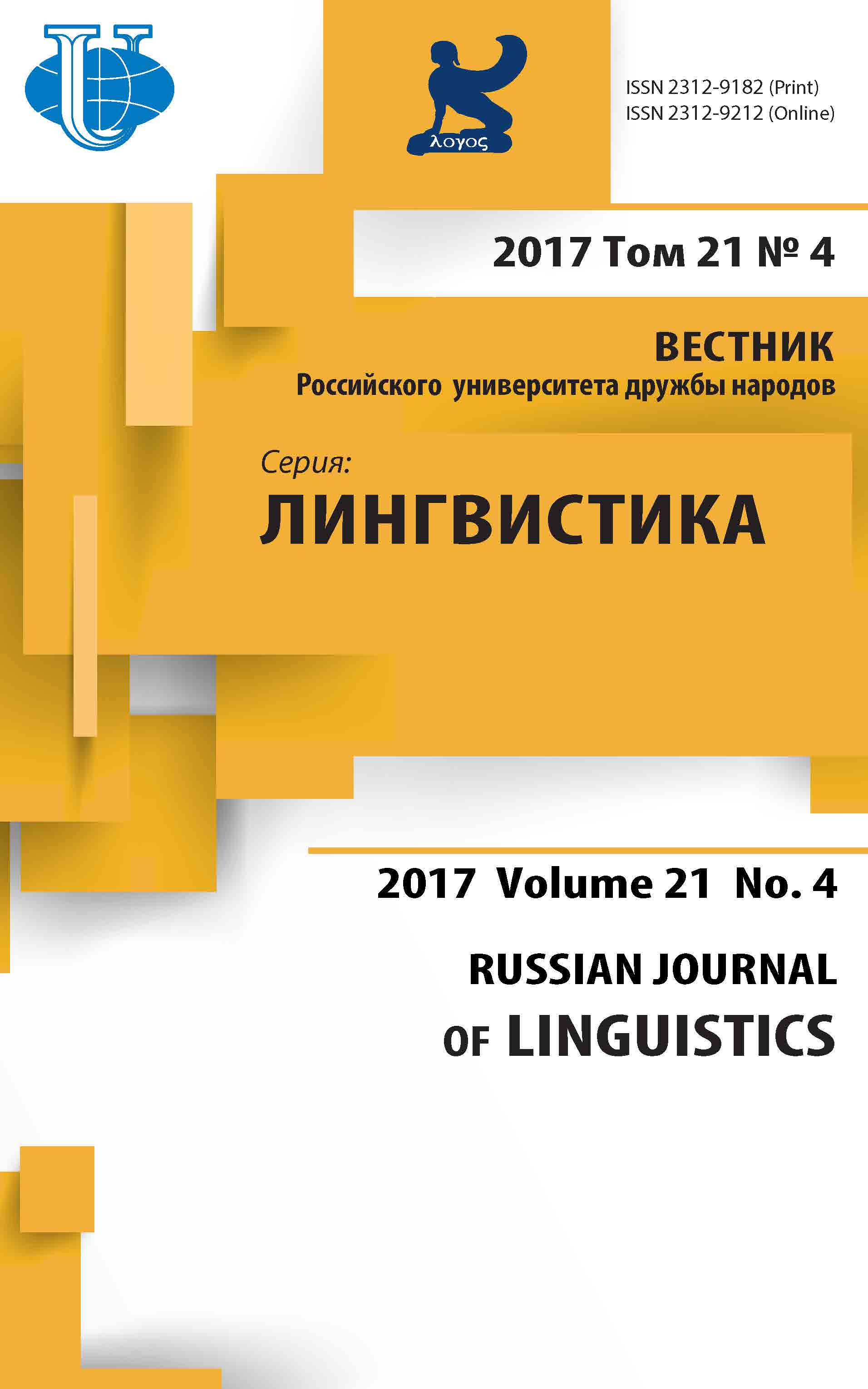INTERCULTURAL COMMUNICATIVE COMPETENCE - A FURTHER CHALLENGE
- Authors: Cranmer R.1
-
Affiliations:
- University of Westminster (Retired 2016)
- Issue: Vol 21, No 4 (2017)
- Pages: 870-884
- Section: Articles
- URL: https://journals.rudn.ru/linguistics/article/view/17315
- DOI: https://doi.org/10.22363/2312-9182-2017-21-4-870-884
- ID: 17315
Cite item
Full Text
Abstract
This article focuses on types of challenge to intercultural communicators arising during communication between those with a good level of intercultural competence and those with a lower level and which relate to communicative style. Those with weaker intercultural competence tend to have limited awareness of variation in communicative style and its link to language and culture. As a result, they often continue using aspects of the communicative style of their first language when using a for-eign language. They may even criticise ethnocentrically aspects of the communicative style associated with that foreign language. This can create specific challenges for a more interculturally competent communicator who may well understand the behaviour in question but find it hard to deal with. The key aim of this article is to analyse these challenges prior to hypothesising what underlying skills and prac-tical strategies might help communicators to deal with them. Relevant skills are sought in existing lit-erature and the further processes used in generating hypotheses are described. Skills are identified which include the capacities to deal with negative comments on your own communicative style, to per-suade your fellow communicator of its validity, to negotiate compromises and to steer the communica-tion towards a mutually satisfactory dynamic. Besides outlining the forms further research needs to take, the article concludes by stressing the importance of better understanding these challenges and of incorporating the development of skills for dealing with them into a variety of teaching programmes containing an intercultural component.
About the authors
Robin Cranmer
University of Westminster (Retired 2016)
Email: robincranmer@yahoo.co.uk
Robin Cranmer, Dr, Senior Lecturer in Intercultural Communication and Language Education, Department of Modern Languages and Cultures, University of Westminster, London (retired in 2016). Research interests: Intercultural Communication, Language Teaching, Translation Studies, Cultural Identity, Philosophy of Language. 309 Regent Street, London W1B 2HW, UK
References
- Bennett, M. J. (1993) Towards ethnorelativism: A developmental model of intercultural sensitivity. In Paige, R. M. (ed.), Education for the Intercultural Experience (2 nd ed.), Yarmouth, ME: Intercultural Press, 21-71.
- Bennett, Milton J. (2004) Becoming Interculturally Competent. In Wurzel, J. (ed.) Becoming Interculturally Competent. Toward multiculturalism: A reader in multicultural education (2 nd ed.). Newton, MA: Intercultural Resource Corporation, 62-77.
- Brown, Rupert (2010) Prejudice: Its Social Psychology (2 nd ed.). Chichester: Wiley-Blackwell.
- Byram, Michael (1997) Teaching and Assessing Intercultural Communicative Competence. Clevedon: Multilingual Matters.
- Byram, Michael (2008) From Foreign Language Education to Education for Intercultural Citizenship. Clevedon: Multilingual Matters.
- Byram, Michael et al. (2004) Intercultural Competence Assessment - The Theory. URL: https://ec.europa.eu/migrant-integration/librarydoc/the-inca-project-intercultural-competenceassessment (accessed 31 August 2017).
- Byram, Michael, Gribkova, Bella Starkey, Hugh (2002) Developing the Intercultural Dimension in Language Teaching. Strasbourg: Council of Europe.
- Cranmer, Robin (2015) Introducing Intercultural Communication into the Teaching of Translation. Russian Journal of Linguistics, 19 (4), 155-176.
- Ekman, P. (1999) Emotional and Conversational Non-verbal Signs. In Messing, L.S. & Campbell, R. (eds.) Gesture, Speech and Sign. New York: OUP, 39-55.
- Guirdham, Maureen and Guirdham, Oliver (2017) Communicating Across Cultures at Work (4 th ed.). Basingstoke: Palgrave Macmillan.
- Hofstede, Geert (1996) Cultures and Organizations: Software of the Mind. New York: McGraw-Hill.
- Holliday, Adrian (2010) Intercultural Communication and Ideology. London: Sage.
- Jack, Gavin and Phipps, Alison (2005) Tourism and Intercultural Exchange. Clevedon: Channel View Publications.
- Kelley, Colleen and Meyers, Judith (1992) The Cross-Cultural Adaptability Inventory. Yarmouth, ME: Intercultural Press.
- Koester, Jolene and Olebe, Margaret (1988) The Behavioural Assessment Scale for Intercultural Communication Effectiveness. International Journal of Intercultural Relations, 12, 233-246.
- Koskinen, Kaisa (2015) Training Translators for a Superdiverse World. Russian Journal of Linguistics, 19 (4), 175-184.
- Kvale, Steinar (1996) Interviews: An Introduction to Qualitative Research Interviewing. Thousand Oaks, CA: Sage.
- Larina, Tatiana (2015) Culture-Specific Communicative Styles as a Framework for Interpreting Linguistic and Cultural Idiosyncrasies. International Review of Pragmatics, 7, 195-215.
- Leontovich, Olga (2015) Cognitive Dissonance from the Intercultural Communication Perspective. Russian Journal of Linguistics, 19 (4), 49-56.
- Lewis, Richard (2005) When Cultures Collide: Leading Across Cultures (3 rd ed.). Nicholas Brealey, London.
- Lustig, Myron W. & Koester, Jolene (2003) Intercultural Competence: Interpersonal Communication Across Cultures (4 th ed.). Boston: Pearson.
- Oakes, Penelope J. and Haslam, S. Alexander (1994) Stereotyping and Social Reality. Oxford: Blackwell.
- Phipps, Alison (2007) Learning the Arts of Linguistic Survival: Languaging, Tourism, Life. Clevedon: Channel View Publications.
- Ruben, B. D. (1977) Guidelines for cross-cultural communication effectiveness. Group & Organization Studies, 2, 470-79.
- Schneider, Susan C. and Barsoux, Jean-Louis (2003) Managing Across Cultures (2 nd ed.). Harlow: Prentice Hall.
- Schrobsdorff, Angelika (1994) Du bist nicht so wie andre Mütter. München: Deutscher Taschenbuch Verlag.
- Scollon, Ron and Scollon, Suzanne Wong (2000) Intercultural Communication: A Discourse Approach. Oxford: Blackwell.
- Spitzberg, B. H. (2000). A model of intercultural communication competence. In Samovar, L. & Porter R. (eds.) Intercultural communication: A reader (9th ed.). Belmont, CA: Wadsworth, 375-387.
- Ter-Minasova, Svetlana (2011) Language, Linguistics and Life: A View from Russia (3 rd ed.). Moscow: URSS.
- Wang, Jiayi and Spencer-Oatey, Helen (2015) The gains and losses of face in ongoing intercultural interaction: a case study of Chinese participant perspectives. Journal of Pragmatics, 89, 50-65.
- Wierzbicka, Anna (2003) Crosscultural Pragmatics: The Semantics of Human Interaction (2 nd ed.). Berlin: Mouton Gruyter.
Supplementary files















